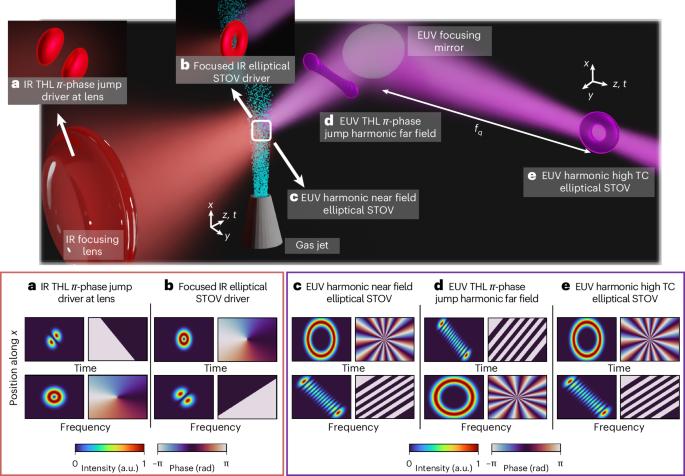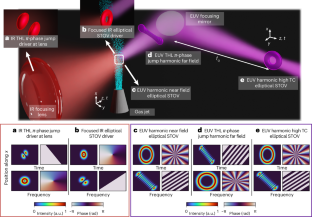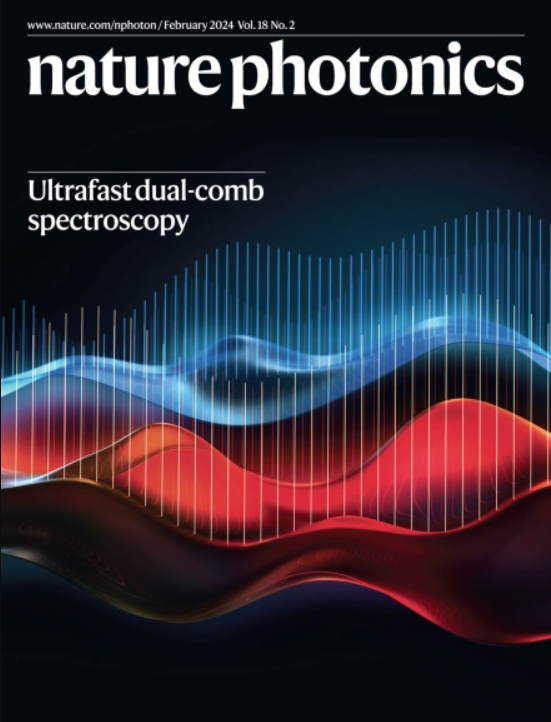高谐波产生的极紫外时空涡旋
IF 32.9
1区 物理与天体物理
Q1 OPTICS
引用次数: 0
摘要
时空光涡旋(stov)是一种具有独特拓扑结构的时空结构光脉冲,它耦合了空间和时间域,并携带横向轨道角动量(OAM)。到目前为止,它们的产生仅限于光谱的可见和红外区域。在过去的十年中,研究表明,通过高次谐波产生过程,可以将携带纵向OAM的空间光学涡流从近红外上转换到极紫外(EUV),从而产生具有不同飞秒和阿秒结构的涡流。在这项工作中,我们从理论上和实验上证明了使用近红外STOV驱动激光脉冲产生的EUV时空和空间光谱涡旋。我们使用聚焦stov的解析表达式进行了高次谐波产生的宏观计算,并与实验结果进行了直接比较。由于STOV光束不是传播的本征模式,我们在近场和远场对高电荷EUV STOV进行了表征,表明它们代表共轭时空和空间光谱涡旋对。我们的工作提供了在纳米/阿秒尺度上与横向OAM拓扑耦合的高频光束,可以适用于探索磁性材料,手性介质和纳米结构中的电子动力学。本文章由计算机程序翻译,如有差异,请以英文原文为准。


Extreme-ultraviolet spatiotemporal vortices via high harmonic generation
Spatiotemporal optical vortices (STOVs) are space–time structured light pulses with a unique topology that couples spatial and temporal domains and carry transverse orbital angular momentum (OAM). Up to now, their generation has been limited to the visible and infrared regions of the spectrum. During the last decade, it was shown that through the process of high-order harmonic generation, it is possible to upconvert spatial optical vortices that carry longitudinal OAM from the near-infrared into the extreme-ultraviolet (EUV), thereby producing vortices with distinct femtosecond and attosecond structure. In this work, we demonstrate theoretically and experimentally the generation of EUV spatiotemporal and spatiospectral vortices using near-infrared STOV driving laser pulses. We use analytical expressions for focused STOVs to perform macroscopic calculations of high-order harmonic generation that are directly compared to the experimental results. As STOV beams are not eigenmodes of propagation, we characterize the highly charged EUV STOVs in both the near and far fields to show that they represent conjugated spatiotemporal and spatiospectral vortex pairs. Our work provides high-frequency light beams topologically coupled at the nanometre/attosecond scales domains with transverse OAM that could be suitable to explore electronic dynamics in magnetic materials, chiral media and nanostructures. The generation of spatiotemporal optical vortices in the extreme-ultraviolet regime is demonstrated via high harmonic generation. Topologically coupled at the nanometre and attosecond domains, these light beams are attractive for exploring electronic dynamics in magnetic materials, chiral media and nanostructures.
求助全文
通过发布文献求助,成功后即可免费获取论文全文。
去求助
来源期刊

Nature Photonics
物理-光学
CiteScore
54.20
自引率
1.70%
发文量
158
审稿时长
12 months
期刊介绍:
Nature Photonics is a monthly journal dedicated to the scientific study and application of light, known as Photonics. It publishes top-quality, peer-reviewed research across all areas of light generation, manipulation, and detection.
The journal encompasses research into the fundamental properties of light and its interactions with matter, as well as the latest developments in optoelectronic devices and emerging photonics applications. Topics covered include lasers, LEDs, imaging, detectors, optoelectronic devices, quantum optics, biophotonics, optical data storage, spectroscopy, fiber optics, solar energy, displays, terahertz technology, nonlinear optics, plasmonics, nanophotonics, and X-rays.
In addition to research papers and review articles summarizing scientific findings in optoelectronics, Nature Photonics also features News and Views pieces and research highlights. It uniquely includes articles on the business aspects of the industry, such as technology commercialization and market analysis, offering a comprehensive perspective on the field.
 求助内容:
求助内容: 应助结果提醒方式:
应助结果提醒方式:


